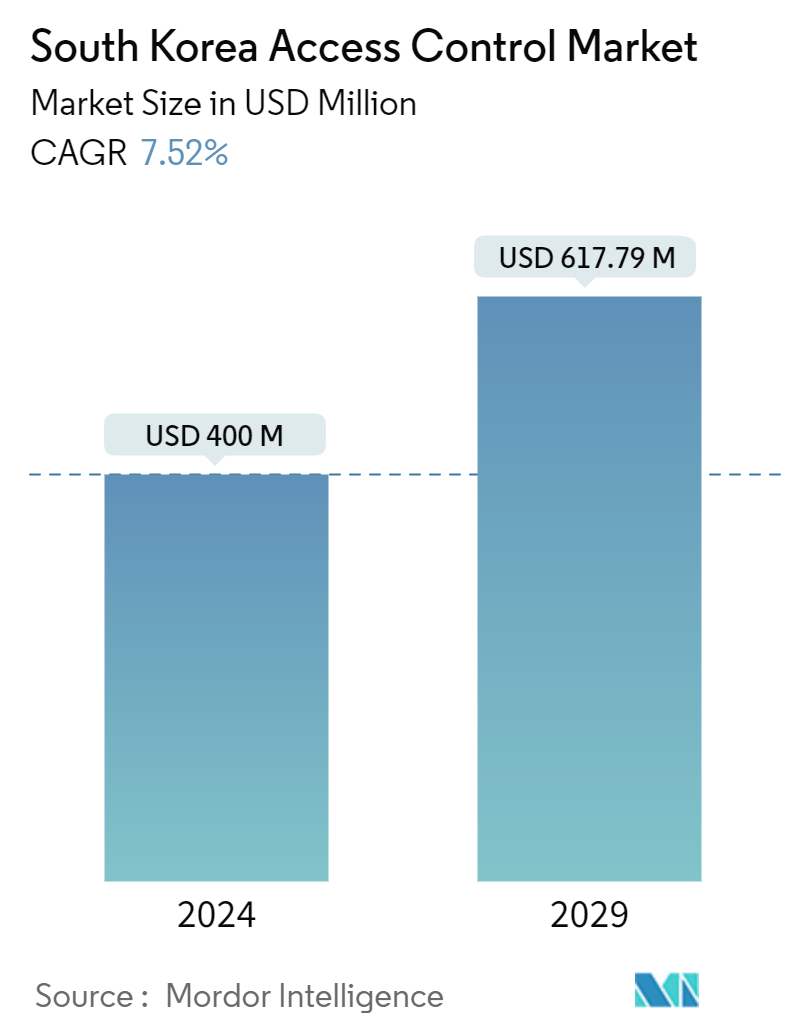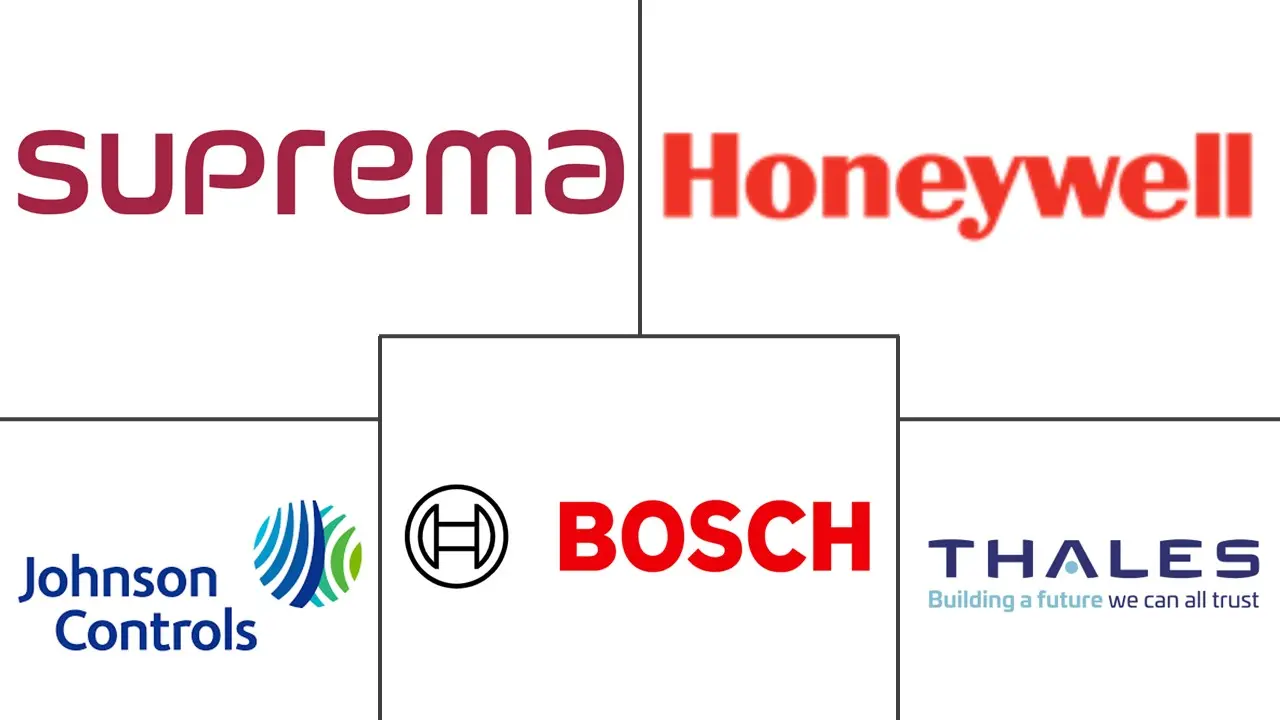Market Size of South Korea Access Control Industry

| Study Period | 2022 - 2029 |
| Base Year For Estimation | 2023 |
| Market Size (2024) | USD 400 Million |
| Market Size (2029) | USD 617.79 Million |
| CAGR (2024 - 2029) | 7.52 % |
| Market Concentration | Low |
Major Players
*Disclaimer: Major Players sorted in no particular order |
South Korea Access Control Market Analysis
The South Korea Access Control Market size is estimated at USD 400 million in 2024, and is expected to reach USD 617.79 million by 2029, growing at a CAGR of 7.52% during the forecast period (2024-2029).
- The market is growing due to the rising need for security applications like biometric readers, card readers, and electronic locks in residential, commercial, and other end-user industries. Owing to the growing security worries and the rise in crime, access control systems are being used increasingly in data centers and office premises, as well as in hotels, entertainment, retail, government, and bank stores.
- The increase in contactless payments after the coronavirus pandemic has also contributed to the market's growth. Using biometric readers allows payment to be verified without contact and the need for a physical card, making it safer and more convenient. The growth of the market in South Korea can be attributed to the increasing number of systems being installed in commercial and defense industries, as well as the large investments made by private and governmental entities to improve data protection and create a safer and more secure environment for their employees.
- Security professionals prefer access control systems due to their user-friendliness, low cost, and non-contact. Most proximity readers are built into the door frame. They work with existing hardware, such as smart locks or deadbolts, and require no software or programming. Many companies are transitioning to touchless access control, which means users don’t need to touch card readers to access the system physically. Proximity card readers eliminate the need for people to physically touch card readers, making it a great choice for many businesses.
- The increasing construction of commercial and residential buildings across the country creates a huge demand for access control solutions. For instance, the government of South Korea is working on several projects that overlook the development of the country’s infrastructure through various government flagship programs. The South Korean government has been in the process of updating its national smart home standards to prepare for the era of the Internet of Things (IoT). Major Korean electronics manufacturers have also worked actively on the IoT and smart homes. The country previously launched an alliance of leading ICT and construction firms, primarily to nurture the smart homes industry.
- The higher cost of initial deployment of smart access control systems may restrict the market's growth. It also takes more time to initiate a code, and biometric systems have a very high incidence of system failure. The lack of technical knowledge and failure of the system due to network loss further hampering the market's growth.
- The rising inflation rates have increased the cost of goods and services, including access control systems. Higher costs are leading to reduced purchasing power for consumers and businesses, slowing down the market's growth. Further, the ongoing war between Russia and Ukraine has disrupted the global supply chain, particularly affecting the availability and cost of electronic components and raw materials used in access control systems. This is leading to delays in production and increased costs for manufacturers.
South Korea Access Control Industry Segmentation
Access control authenticates users through various credentials, from traditional usernames and passwords to advanced methods like biometric scans and security tokens. These systems often feature physical barriers, like locked doors or gates, which are unlocked using RFID access cards, pin codes, facial recognition, fingerprints, or even smartphones, granting access to designated areas. The study tracks the revenue accrued through the sale of access control solutions by various players in the South Korean market. The study also tracks the key market parameters, underlying growth influencers, and major vendors operating in the industry, which supports the market estimations and growth rates during the forecast period. The study further analyses the overall impact of aftereffects of the COVID-19 pandemic and other macroeconomic factors on the market. The report’s scope encompasses market sizing and forecasts for the various market segments.
The South Korean access control market is segmented by type (card reader and access control devices (card-based, proximity, smart card (contact and contactless)), biometric readers, electronic locks, and software) and end-user vertical (commercial, residential, government, industrial, transport and logistics, healthcare, and military and defense). The market sizes and forecasts are provided in terms of value (USD) for all the segments.
| By Type | |||||
| |||||
| Biometric Readers | |||||
| Electronic Locks | |||||
| Software | |||||
| Other Types |
| By End-user Vertical | |
| Commercial | |
| Residential | |
| Government | |
| Industrial | |
| Transport and Logistics | |
| Healthcare | |
| Military and Defense | |
| Other End-user Verticals |
South Korea Access Control Market Size Summary
The South Korean access control market is experiencing significant growth, driven by the increasing demand for security solutions such as biometric readers, card readers, and electronic locks across various sectors, including residential, commercial, and government industries. The rise in security concerns and crime rates has led to a heightened adoption of access control systems in data centers, office premises, hotels, retail, and banking sectors. The shift towards contactless payment methods, accelerated by the COVID-19 pandemic, has further fueled market expansion, as biometric readers offer safer and more convenient payment verification. The market's growth is also supported by substantial investments from both private and governmental entities aimed at enhancing data protection and creating secure environments. The transition to touchless access control systems, which eliminate the need for physical contact, is gaining traction, particularly in commercial and defense sectors.
The South Korean access control market is characterized by its competitive landscape, with both global and regional players vying for market share. The residential sector holds a significant portion of the market due to government initiatives and investments in new housing projects, particularly in urban areas like Seoul. The ongoing digitalization and the rollout of 5G networks are expected to further drive demand for access control software. However, challenges such as high initial deployment costs, system failures, and supply chain disruptions due to global events like the Russia-Ukraine war pose obstacles to market growth. Despite these challenges, the market continues to evolve, with innovations such as Suprema Inc.'s on-device biometric authentication and Allegion PLC's new electronic lock portfolio enhancing security solutions. The market's future growth is anticipated to be bolstered by infrastructure development, increased digitalization, and the need for advanced security systems in response to rising crime rates.
South Korea Access Control Market Size - Table of Contents
-
1. MARKET INSIGHTS
-
1.1 Market Overview
-
1.2 Industry Attractiveness - Porter's Five Forces Analysis
-
1.2.1 Threat of New Entrants
-
1.2.2 Bargaining Power of Buyers/Consumers
-
1.2.3 Bargaining Power of Suppliers
-
1.2.4 Threat of Substitute Products
-
1.2.5 Intensity of Competitive Rivalry
-
-
1.3 Industry Value Chain Analysis
-
1.4 Impact of the Aftereffects of the COVID-19 pandemic and Other Macroeconomic Factors on the Market
-
-
2. MARKET SEGMENTATION
-
2.1 By Type
-
2.1.1 Card Reader and Access Control Devices
-
2.1.1.1 Card-based
-
2.1.1.2 Proximity
-
2.1.1.3 Smart Card (Contact and Contactless)
-
-
2.1.2 Biometric Readers
-
2.1.3 Electronic Locks
-
2.1.4 Software
-
2.1.5 Other Types
-
-
2.2 By End-user Vertical
-
2.2.1 Commercial
-
2.2.2 Residential
-
2.2.3 Government
-
2.2.4 Industrial
-
2.2.5 Transport and Logistics
-
2.2.6 Healthcare
-
2.2.7 Military and Defense
-
2.2.8 Other End-user Verticals
-
-
South Korea Access Control Market Size FAQs
How big is the South Korea Access Control Market?
The South Korea Access Control Market size is expected to reach USD 400 million in 2024 and grow at a CAGR of 7.52% to reach USD 617.79 million by 2029.
What is the current South Korea Access Control Market size?
In 2024, the South Korea Access Control Market size is expected to reach USD 400 million.

